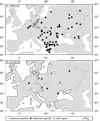Widespread unidirectional transfer of mitochondrial DNA: a case in western Palaearctic water frogs
- PMID: 18373588
- PMCID: PMC2505272
- DOI: 10.1111/j.1420-9101.2008.01527.x
Widespread unidirectional transfer of mitochondrial DNA: a case in western Palaearctic water frogs
Abstract
Interspecies transfer of mitochondrial (mt) DNA is a common phenomenon in plants, invertebrates and vertebrates, normally linked with hybridization of closely related species in zones of sympatry or parapatry. In central Europe, in an area north of 48 degrees N latitude and between 8 degrees and 22 degrees E longitude, western Palaearctic water frogs show massive unidirectional introgression of mtDNA: 33.7% of 407 Rana ridibunda possessed mtDNA specific for Rana lessonae. By contrast, no R. lessonae with R. ridibunda mtDNA was observed. That R. ridibunda with introgressed mitochondrial genomes were found exclusively within the range of the hybrid Rana esculenta and that most hybrids had lessonae mtDNA (90.4% of 335 individuals investigated) is evidence that R. esculenta serves as a vehicle for transfer of lessonae mtDNA into R. ridibunda. Such introgression has occurred several times independently. The abundance and wide distribution of individuals with introgressed mitochondrial genomes show that R. lessonae mt genomes work successfully in a R. ridibunda chromosomal background despite their high sequence divergence from R. ridibunda mtDNAs (14.2-15.2% in the ND2/ND3 genes). Greater effectiveness of enzymes encoded by R. lessonae mtDNA may be advantageous to individuals of R. ridibunda and probably R. esculenta in the northern parts of their ranges.
Figures


Similar articles
-
Natural interspecies transfer of mitochondrial DNA in amphibians.Proc Natl Acad Sci U S A. 1984 Sep;81(18):5802-5. doi: 10.1073/pnas.81.18.5802. Proc Natl Acad Sci U S A. 1984. PMID: 6091109 Free PMC article.
-
Evolutionary history of the hybridogenetic hybrid frog Rana esculenta as deduced from mtDNA analyses.Mol Biol Evol. 1986 Jan;3(1):44-56. doi: 10.1093/oxfordjournals.molbev.a040376. Mol Biol Evol. 1986. PMID: 2832687
-
Mitochondrial DNA reveals formation of nonhybrid frogs by natural matings between hemiclonal hybrids.Mol Biol Evol. 1992 Jul;9(4):610-20. doi: 10.1093/oxfordjournals.molbev.a040744. Mol Biol Evol. 1992. PMID: 1352842
-
Lampbrush and mitotic chromosomes of the hemiclonally reproducing hybrid Rana esculenta and its parental species.J Exp Zool. 1990 Jul;255(1):37-56. doi: 10.1002/jez.1402550107. J Exp Zool. 1990. PMID: 2391468
-
Gametogenesis of intergroup hybrids of hemiclonal frogs.Genet Res. 2007 Feb;89(1):39-45. doi: 10.1017/S0016672307008610. Genet Res. 2007. PMID: 17517158
Cited by
-
Balancing a cline by influx of migrants: a genetic transition in water frogs of eastern Greece.J Hered. 2013 Jan-Feb;104(1):57-71. doi: 10.1093/jhered/ess086. Epub 2012 Nov 1. J Hered. 2013. PMID: 23125403 Free PMC article.
-
RrS1-like sequences of water frogs from Central Europe and around the Aegean Sea: chromosomal organization, evolution, possible function.J Mol Evol. 2011 Apr;72(4):368-82. doi: 10.1007/s00239-011-9436-5. Epub 2011 Mar 20. J Mol Evol. 2011. PMID: 21424546
-
Inheritance patterns of male asexuality in hybrid males of a water frog Pelophylax esculentus.Sci Rep. 2024 Sep 27;14(1):22221. doi: 10.1038/s41598-024-73043-1. Sci Rep. 2024. PMID: 39333615 Free PMC article.
-
Distinguishing between incomplete lineage sorting and genomic introgressions: complete fixation of allospecific mitochondrial DNA in a sexually reproducing fish (Cobitis; Teleostei), despite clonal reproduction of hybrids.PLoS One. 2014 Jun 27;9(6):e80641. doi: 10.1371/journal.pone.0080641. eCollection 2014. PLoS One. 2014. PMID: 24971792 Free PMC article.
-
Sperm-dependent asexual hybrids determine competition among sexual species.Sci Rep. 2019 Jan 24;9(1):722. doi: 10.1038/s41598-018-35167-z. Sci Rep. 2019. PMID: 30679449 Free PMC article.
References
-
- Abe TA, Spence JR, Sperling FAH. Mitochondrial introgression is restricted relative to nuclear markers in a water strider (Hemiptera: Gerridae) hybrid zone. Can. J. Zoolog. 2005;83:432–444.
-
- Babik W, Branicki W, Crnobrnja-Isailović J, Cogălniceanu D, Sas I, Olgun K, Poyarkov HA, Garcia-París M, Arntzen JW. Phylogeography of two European newt species – discordance between mtDNA and morphology. Mol. Ecol. 2005;14:2475–2491. - PubMed
-
- Bachtrog D, Thornton K, Clark A, Andolfatto P. Extensive introgression of mitochondrial DNA relative to nuclear genes in the Drosophila yakuba species group. Evolution. 2006;60:292–302. - PubMed
-
- Ballard JWO, Whitlock MC. The incomplete natural history of mitochondria. Mol. Ecol. 2004;13:729–744. - PubMed
-
- Bazin E, Glémin S, Galtier N. Population size does not influence mitochondrial genetic diversity in animals. Science. 2006;312:570–572. - PubMed

